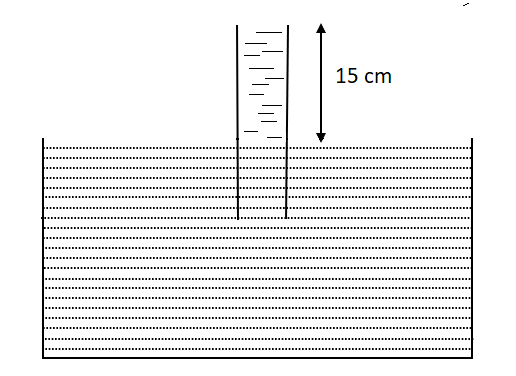
When a long glass capillary tube of radius 0.015 cm is dipped in a liquid, the liquid rises to a height of 15 cm within it. If the contact angle between the liquid and glass to close to \[{0^0}\], the surface tension of the liquid, in milliNewton \[{m^{ - 1}}\] , is [\[{\rho _{(liquid)}} = 900kg{m^{ - 3}},g = 10m{s^{ - 2}}\]] (Give answer in closes integer)
Answer
221.7k+ views
Hint:If a capillary is inserted in a liquid, its height will increase. This rise in liquid in the capillary is due to surface tension. The capillary rise of a liquid is determined by the surface tension, density of the liquid, viscosity of the liquid, and diameter of the capillary tube.
Formula used:
Rise in the capillary is given as,
\[h = \dfrac{{2T\cos \theta }}{{\rho gr}}\]
Where T is surface tension
\[\theta \] is angle of contact
\[\rho \] is density
g is acceleration due to gravity
r is radius of capillary
Complete answer:
Given radius of the capillary, r = 0.015 cm =\[0.015 \times {10^{ - 2}}m\]
Liquid rises to a height, h = 15 cm = \[15 \times {10^{ - 2}}m\]
Angle of contact, \[\theta = {0^0}\]

Figure: Rise in liquid in the capillary.
As we know that,
Rise in the capillary, \[h = \dfrac{{2T\cos \theta }}{{\rho gr}}\]
Or,
\[T = \dfrac{{h\rho gr}}{{2\cos \theta }}\]
By substituting the given values, we get
\[T = \dfrac{{(15 \times {{10}^{ - 2}}) \times 900 \times 10 \times (0.015 \times {{10}^{ - 2}})}}{{2 \times \cos {0^0}}}\] (\[\cos {0^0} = 1\] )
\[T = 1012.5 \times {10^{ - 4}}N{m^{ - 1}}\]
\[T = 101.25 \times {10^{ - 3}}N{m^{ - 1}}\]
\[T = 101{\rm{ milliNewton}}{m^{ - 1}}\]
Hence, the surface tension of the liquid, in milliNewton \[{m^{ - 1}}\]is \[T = 101{\rm{ milliNewton}}{m^{ - 1}}\]
Note: The rise of liquid in the capillary tube is due to the forces of adhesion, cohesion, and surface tension. If adhesive force (liquid-capillary) is greater than the cohesive force (liquid-liquid) then the liquid will rise in the liquid in the capillary tube.
The formula for capillary rise may be derived by balancing forces on the liquid column. The weight of the liquid is balanced by the upward force due to surface tension. This formula can also be derived using pressure balance.
Formula used:
Rise in the capillary is given as,
\[h = \dfrac{{2T\cos \theta }}{{\rho gr}}\]
Where T is surface tension
\[\theta \] is angle of contact
\[\rho \] is density
g is acceleration due to gravity
r is radius of capillary
Complete answer:
Given radius of the capillary, r = 0.015 cm =\[0.015 \times {10^{ - 2}}m\]
Liquid rises to a height, h = 15 cm = \[15 \times {10^{ - 2}}m\]
Angle of contact, \[\theta = {0^0}\]

Figure: Rise in liquid in the capillary.
As we know that,
Rise in the capillary, \[h = \dfrac{{2T\cos \theta }}{{\rho gr}}\]
Or,
\[T = \dfrac{{h\rho gr}}{{2\cos \theta }}\]
By substituting the given values, we get
\[T = \dfrac{{(15 \times {{10}^{ - 2}}) \times 900 \times 10 \times (0.015 \times {{10}^{ - 2}})}}{{2 \times \cos {0^0}}}\] (\[\cos {0^0} = 1\] )
\[T = 1012.5 \times {10^{ - 4}}N{m^{ - 1}}\]
\[T = 101.25 \times {10^{ - 3}}N{m^{ - 1}}\]
\[T = 101{\rm{ milliNewton}}{m^{ - 1}}\]
Hence, the surface tension of the liquid, in milliNewton \[{m^{ - 1}}\]is \[T = 101{\rm{ milliNewton}}{m^{ - 1}}\]
Note: The rise of liquid in the capillary tube is due to the forces of adhesion, cohesion, and surface tension. If adhesive force (liquid-capillary) is greater than the cohesive force (liquid-liquid) then the liquid will rise in the liquid in the capillary tube.
The formula for capillary rise may be derived by balancing forces on the liquid column. The weight of the liquid is balanced by the upward force due to surface tension. This formula can also be derived using pressure balance.
Recently Updated Pages
States of Matter Chapter For JEE Main Chemistry

Mass vs Weight: Key Differences Explained for Students

Circuit Switching vs Packet Switching: Key Differences Explained

Conduction Explained: Definition, Examples & Science for Students

Balancing of Redox Reactions - Important Concepts and Tips for JEE

Atomic Size - Important Concepts and Tips for JEE

Trending doubts
JEE Main 2026: Application Form Open, Exam Dates, Syllabus, Eligibility & Question Papers

Derivation of Equation of Trajectory Explained for Students

Hybridisation in Chemistry – Concept, Types & Applications

Understanding the Angle of Deviation in a Prism

How to Convert a Galvanometer into an Ammeter or Voltmeter

Degree of Dissociation: Meaning, Formula, Calculation & Uses

Other Pages
JEE Advanced Marks vs Ranks 2025: Understanding Category-wise Qualifying Marks and Previous Year Cut-offs

Thermodynamics Class 11 Physics Chapter 11 CBSE Notes - 2025-26

Units And Measurements Class 11 Physics Chapter 1 CBSE Notes - 2025-26

NCERT Solutions For Class 11 Physics Chapter 8 Mechanical Properties Of Solids

Motion in a Straight Line Class 11 Physics Chapter 2 CBSE Notes - 2025-26

Laws of Motion Class 11 Physics Chapter 4 CBSE Notes - 2025-26




